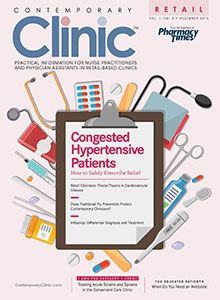Some OTC Products May Cause Liver Damage
The use of dietary and herbal supplementation continues to increase across the United States and Europe.
The use of dietary and herbal supplementation continues to increase across the United States and Europe. A big reason for the increase is the public’s perception that natural equals healthy.
The “natural is better” trend emphasizes the health benefits of natural products, but tells little of the dangers of taking dietary and herbal supplements without proper knowledge of adverse effects.
According to a review article inArchives of Toxicology, supplements contain adulterants and varying concentrations of active ingredients within batches, as they are only very loosely regulated by the FDA. In addition, several OTC supplements may cause liver damage. The possibility of liver damage due to supplements is strong enough to warrant intervention by health care professionals, as there are no specific tests to determine whether supplements are the cause.
Hepatotoxicosis can be transient or permanent, depending on the agent. Supplements that can cause liver damage include comfrey, ragwort, some Chinese herbals, germander, chaparral, pennyroyal, celandine, kava, and black cohosh.
Even seemingly beneficial herbals may possibly pose a hepatotoxic risk. There have been conflicting reports of an association between green tea supplements and liver problems; however, in most case reports citing liver injury, the patients were also taking known hepatotoxic agents. Some Herbalife products have reportedly caused liver damage, although the specific products are not known because the affected patients took multiple Herbalife products simultaneously. Some weight loss aids and anabolic steroids may be associated with hepatotoxicity.
It is critical to inform patients that natural does not equal healthy. OTC supplement use must be discussed with a health care provider. As with prescription medications, patients need to understand the risks associated with supplement use. Providers must take initiative to act on suspected liver damage due to supplement use, even without concrete evidence.

Knock Out Aches and Pains From Cold
October 30th 2019The symptoms associated with colds, most commonly congestion, coughing, sneezing, and sore throats, are the body's response when a virus exerts its effects on the immune system. Cold symptoms peak at about 1 to 2 days and last 7 to 10 days but can last up to 3 weeks.
COPD: Should a Clinician Treat or Refer?
October 27th 2019The Global Initiative for Chronic Obstructive Lung Disease (GOLD) defines the condition as follows: “COPD is a common, preventable, and treatable disease that is characterized by persistent respiratory symptoms and airflow limitation that is due to airway and/or alveolar abnormalities usually caused by significant exposure to noxious particles or gases.â€
Diabetic Ketoacidosis Is Preventable With Proper Treatment
October 24th 2019Cancer, diabetes, and heart disease account for a large portion of the $3.3 trillion annual US health care expenditures. In fact, 90% of these expenditures are due to chronic conditions. About 23 million people in the United States have diabetes, 7 million have undiagnosed diabetes, and 83 million have prediabetes.
What Are the Latest Influenza Vaccine Recommendations?
October 21st 2019Clinicians should recommend routine yearly influenza vaccinations for everyone 6 months or older who has no contraindications for the 2019-2020 influenza season starting at the end of October, according to the Advisory Committee on Immunization Practices.
What Is the Best Way to Treat Pharyngitis?
October 18th 2019There are many different causes of throat discomfort, but patients commonly associate a sore throat with an infection and may think that they need antibiotics. This unfortunately leads to unnecessary antibiotic prescribing when clinicians do not apply evidence-based practice.
